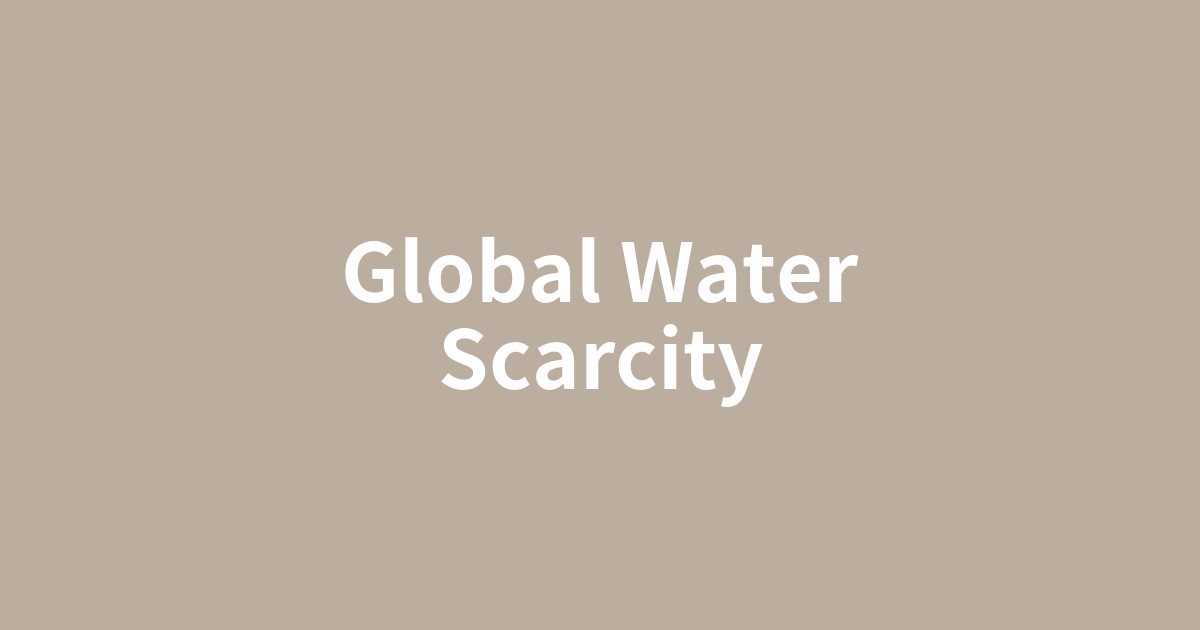このページは、歴史や文化の物語を楽しみながら、その文脈の中で重要な英単語を自然に学ぶための学習コンテンツです。各セクションの下にあるボタンで、いつでも日本語と英語を切り替えることができます。背景知識を日本語で学んだ後、英語の本文を読むことで、より深い理解と語彙力の向上を目指します。

【ご注意】
この記事には、健康、金融、法律など、読者の人生に大きな影響を与える可能性のある情報が含まれています。内容は一般的な情報提供を目的としており、専門的なアドバイスに代わるものではありません。重要な判断を下す前には、必ず資格を持つ専門家にご相談ください。
地球は水の惑星だが、私たちが使える真水はごく僅か。人口増加や気候変動によって深刻化する、安全な水へのaccess(アクセス)をめぐる問題。
この記事で抑えるべきポイント
- ✓地球上の水のうち人間が利用しやすい淡水は全体の約0.01%に過ぎず、極めて希少な資源であるという事実。
- ✓世界の水不足は、単なる自然現象ではなく、人口増加、気候変動、水の汚染、社会インフラの未整備といった複合的な要因によって引き起こされていること。
- ✓水問題は「渇き」だけでなく、不衛生な水による感染症など、人々の健康や生命に直結する公衆衛生上の課題であること。
- ✓水汲みによる教育機会の喪失や、水資源をめぐる国家間の対立など、水不足が貧困、ジェンダー、地政学といった社会問題と密接に結びついていること。
世界の水不足問題 ― 安全な水にアクセスできない人々
「水の惑星」と呼ばれる地球。私たち日本に住む者にとって、蛇口をひねれば清浄な水がいつでも手に入るのは当たり前の日常です。しかし、その日常は世界では決して当たり前ではありません。この記事では、なぜ安全な水へのアクセス(access)がこれほど深刻な世界規模の課題となっているのか、その複雑な背景と構造を紐解いていきます。
The Global Water Scarcity Issue: People Without Access to Safe Water
Earth is often called the "Water Planet." For those of us living in Japan, it's a part of daily life to turn on a tap and have clean water readily available. However, this reality is not a given worldwide. In this article, we will unravel the complex background and structure behind why access to safe water has become such a serious global issue.
数字で見る「水の惑星」の意外な素顔
地球に存在する水の総量は膨大ですが、そのうち約97.5%は海水です。私たちが生命維持や社会活動に利用できる淡水(freshwater)は、わずか2.5%に過ぎません。さらに、その大半は南極や北極の氷、あるいは地下深くに存在するため、私たちが比較的容易に利用できる河川や湖沼の水は、地球上の水全体の約0.01%しかないのです。この事実は、水がいかに希少で価値のある資源(resource)であるかを物語っています。
The Surprising Truth of the "Water Planet" in Numbers
While the total amount of water on Earth is vast, about 97.5% of it is saltwater. The freshwater we can use for life and societal activities accounts for a mere 2.5%. Furthermore, most of that is locked away in glaciers in Antarctica and the Arctic, or deep underground. The water in rivers and lakes that we can relatively easily use makes up only about 0.01% of all water on Earth. This fact illustrates just how scarce and valuable a resource water truly is.
なぜ水は足りなくなるのか?水不足を引き起こす複合的な要因
世界の水不足は、単一の原因で発生するわけではありません。まず、世界的な人口増加により、生活用水や農業用水、工業用水の需要が急増しています。それに加え、近年の気候変動(climate change)は、世界各地で深刻な干ばつや洪水を頻発させ、降水パターンを不安定にしています。これにより、これまで水が豊富だった地域でも水不足が起こり始めています。さらに、工場排水や生活排水、農薬の流入による水の汚染(contamination)も深刻な問題です。利用できる水の「量」だけでなく「質」も低下させ、事態をより複雑にしています。
Why Is Water Becoming Scarce? The Complex Factors Causing Water Shortages
Global water scarcity does not arise from a single cause. Firstly, the global population increase is causing a sharp rise in demand for domestic, agricultural, and industrial water. In addition, recent climate change is causing frequent and severe droughts and floods around the world, making precipitation patterns unstable. This is beginning to cause water shortages even in regions that were previously water-rich. Furthermore, water contamination from industrial and domestic wastewater, as well as agricultural pesticides, is a serious problem. It degrades not only the "quantity" but also the "quality" of available water, making the situation more complex.
命を脅かす「見えないリスク」とインフラの壁
水問題の本質は、単なる「渇き」の問題にとどまりません。それは人々の「命」に直結する課題です。安全な水を安定して供給するためには、浄水場や水道網、下水処理施設といった社会基盤(infrastructure)が不可欠です。しかし、開発途上国の多くではこれらの整備が追いついていません。結果として、人々は病原菌に汚染された水を飲まざるを得ず、コレラや赤痢といった感染症が蔓延する原因となっています。安全な水の確保は、公衆衛生(sanitation)の向上と表裏一体の重要な課題なのです。
The "Invisible Risk" Threatening Lives and the Infrastructure Barrier
The essence of the water problem goes beyond just the issue of "thirst." It is an issue directly linked to people's "lives." To supply safe water stably, social infrastructure such as water treatment plants, pipe networks, and sewage facilities is essential. However, in many developing countries, the development of this infrastructure has not kept pace. As a result, people are forced to drink water contaminated with pathogens, leading to the spread of infectious diseases like cholera and dysentery. Securing safe water is a critical task that is two sides of the same coin with improving public sanitation.
水問題は社会の鏡:貧困、ジェンダー、そして紛争
水へのアクセスの不均衡は、社会の歪みを映し出す鏡でもあります。特に農村部や貧困地域では、水汲みが女性や子供たちの重労働となっており、学校に通う時間を奪い、教育の機会を喪失させています。これは、水へのアクセスにおける公平性(equity)が著しく欠けている現実を示しています。さらに、国境を越えて流れる河川の利用権をめぐり、流域国同士の対立や紛争(conflict)に発展するケースも少なくありません。水は、時として平和を脅かす戦略的な資源にもなり得るのです。
Water Issues as a Mirror of Society: Poverty, Gender, and Conflict
The imbalance in water access also serves as a mirror reflecting societal distortions. Particularly in rural and impoverished areas, fetching water becomes heavy labor for women and children, robbing them of time to attend school and causing a loss of educational opportunities. This demonstrates a significant lack of equity in water access. Moreover, disputes over the rights to use transboundary rivers often escalate into tensions and conflict between basin countries. Water can, at times, become a strategic resource that threatens peace.
私たちの未来と「持続可能性」という視点
ここまで見てきたように、水不足は遠い国の出来事ではありません。私たちが日々消費する食料や工業製品は、その生産過程で大量の水を必要とします。つまり、輸入を通じて、私たちは世界の水問題と間接的に繋がっているのです。このグローバルな課題に対して、私たち一人ひとりができることは何でしょうか。節水を心がけることはもちろん、水問題の背景にある構造を理解し、関心を持ち続けることが第一歩です。未来の世代も安心して水を使える社会を築くために、持続可能性(sustainability)という視点から、この問題と向き合っていくことが今、求められています。
Our Future and the Perspective of Sustainability
As we have seen, water scarcity is not a distant problem. The food and industrial products we consume daily require large amounts of water in their production processes. This means that through imports, we are indirectly connected to the world's water problems. What can each of us do about this global issue? While practicing water conservation is important, the first step is to understand the structure behind the water problem and to remain engaged. To build a society where future generations can also use water with peace of mind, it is now required of us to face this issue from the perspective of sustainability.
テーマを理解する重要単語
resource
水を単なる液体としてではなく、生命や社会活動を支える価値ある「資源」として捉える視点を与えてくれる単語です。この記事では、水の希少性や、それを巡って時に紛争さえ起きるという文脈で使われており、水問題の経済的・戦略的な側面を理解する鍵です。
文脈での用例:
Water is a precious natural resource.
水は貴重な天然資源です。
conflict
水が平和を脅かす戦略的資源にもなり得る、という記事の指摘を理解するためのキーワードです。国境を越える河川の利用権などを巡る国家間の深刻な「対立」や「紛争」を指します。この単語は、水問題が単なる環境問題ではなく、地政学的なリスクもはらんでいることを示唆しています。
文脈での用例:
His report conflicts with the official version of events.
彼の報告は、公式発表の出来事と矛盾している。
access
この記事の核心テーマ「安全な水へのアクセス」で繰り返し使われる最重要単語です。単に物理的に近づけるだけでなく、それを利用する権利というニュアンスを含みます。水問題が基本的人権に関わる課題であることを理解する上で不可欠な言葉と言えるでしょう。
文脈での用例:
This ticket gives you access to all the museum's exhibitions.
このチケットで、博物館のすべての展示にアクセスできます。
infrastructure
浄水場や水道網、下水処理施設といった「社会基盤」を指す言葉です。安全な水を安定的に供給するには、このインフラ整備が不可欠です。この記事では、特に開発途上国が直面する課題の核心として登場し、問題解決の難しさを具体的に理解させてくれます。
文脈での用例:
The government invested heavily in public infrastructure like roads and bridges.
政府は道路や橋のような公共の社会基盤に多額の投資を行った。
sanitation
水問題が「命」に直結する理由を解き明かす鍵となる単語です。単なる清潔さではなく、下水処理システムを含む「公衆衛生」全般を指します。安全な水の確保が、コレラなどの感染症を防ぐための公衆衛生の向上と表裏一体であることを示す、専門性の高い語彙です。
文脈での用例:
Poor sanitation can lead to the spread of disease.
劣悪な公衆衛生は病気の蔓延につながる可能性がある。
contamination
水不足が利用できる水の「量」だけでなく「質」の問題でもあることを示す重要な単語です。工場排水や農薬による「汚染」が、ただでさえ希少な水資源をさらに危険なものに変えてしまう現実を浮き彫りにします。pollutionよりも、特定の物質が混入するニュアンスが強いです。
文脈での用例:
The factory was closed due to chemical contamination of the nearby river.
その工場は、近くの川の化学物質汚染のために閉鎖された。
climate change
水不足を引き起こす複合的な要因の一つとして挙げられる「気候変動」。この言葉は、干ばつや降水パターンの変化といった具体的な事象と水問題を結びつけます。現代社会が直面する最も大きな課題の一つであり、この記事の背景を理解する上で欠かせない概念です。
文脈での用例:
Scientists are debating how climate change affects the frequency of El Niño.
科学者たちは気候変動がエルニーニョの頻度にどう影響するかを議論しています。
equity
水へのアクセスの不均衡が社会の歪みを映し出す、と論じる部分で使われる単語です。全員に同じものを与える「equality(平等)」とは異なり、個々の状況に応じて機会を「公平」に提供するというニュアンスを持ちます。水汲み労働が女性や子供の教育機会を奪うという文脈で、この言葉の重要性が際立ちます。
文脈での用例:
Achieving equity in education means ensuring all children have the opportunity to succeed.
教育における公平性を達成するとは、すべての子どもたちが成功する機会を得られるようにすることです。
sustainability
この記事の結論部分で、私たちに求められる視点として提示される現代の最重要概念です。「持続可能性」とは、未来の世代のニーズを損なうことなく、現代のニーズを満たすことを意味します。水問題を一過性の出来事ではなく、長期的に取り組むべきグローバルな課題として捉え直すために不可欠な言葉です。
文脈での用例:
The company is focused on the long-term sustainability of its business.
その企業は自社のビジネスの長期的な持続可能性に重点を置いている。
freshwater
地球上の水の97.5%が海水であるという事実に対し、私たちが生命維持に使える「淡水」の希少性を際立たせる単語です。この記事の序盤で提示される「水の惑星」の意外な実態を理解するために必須の語彙であり、水問題の規模感を把握する出発点となります。
文脈での用例:
Only a tiny fraction of the Earth's water is freshwater available for human use.
地球の水のうち、人間が利用できる淡水はごくわずかな割合に過ぎません。